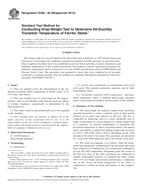Potřebujeme váš souhlas k využití jednotlivých dat, aby se vám mimo jiné mohly ukazovat informace týkající se vašich zájmů. Souhlas udělíte kliknutím na tlačítko „OK“.
ASTM E9-09
Standard Test Methods of Compression Testing of Metallic Materials at Room Temperature
Automaticky přeložený název:
Standardní testovací metody komprese zkoušení kovových materiálů při pokojové teplotě
NORMA vydána dne 1.11.2009
Informace o normě:
Označení normy: ASTM E9-09
Poznámka: NEPLATNÁ
Datum vydání normy: 1.11.2009
Kód zboží: NS-48410
Počet stran: 9
Přibližná hmotnost: 27 g (0.06 liber)
Země: Americká technická norma
Kategorie: Technické normy ASTM
Kategorie - podobné normy:
Anotace textu normy ASTM E9-09 :
Keywords:
., ICS Number Code 77.040.10 (Mechanical testing of metals)
Doplňující informace
| Significance and Use | ||||||||||||||||||||
|
Significance—The data obtained from a compression test may include the yield strength, the yield point, Young's modulus, the stress-strain curve, and the compressive strength (see Terminology E6). In the case of a material that does not fail in compression by a shattering fracture, compressive strength is a value that is dependent on total strain and specimen geometry. Use—Compressive properties are of interest in the analyses of structures subject to compressive or bending loads or both and in the analyses of metal working and fabrication processes that involve large compressive deformation such as forging and rolling. For brittle or nonductile metals that fracture in tension at stresses below the yield strength, compression tests offer the possibility of extending the strain range of the stress-strain data. While the compression test is not complicated by necking as is the tension test for certain metallic materials, buckling and barreling (see Section 3) can complicate results and should be minimized. |
||||||||||||||||||||
| 1. Scope | ||||||||||||||||||||
|
1.1 These test methods cover the apparatus, specimens, and procedure for axial-load compression testing of metallic materials at room temperature (Note 1). For additional requirements pertaining to cemented carbides, see Annex A1. Note 1—For compression tests at elevated temperatures, see Practice E209. 1.2 The values stated in inch-pound units are to be regarded as standard. The values given in parentheses are mathematical conversions to SI units that are provided for information only and are not considered standard. 1.3 This standard does not purport to address all of the safety concerns, if any, associated with its use. It is the responsibility of the user of this standard to establish appropriate safety and health practices and determine the applicability of regulatory limitations prior to use. |
||||||||||||||||||||
| 2. Referenced Documents | ||||||||||||||||||||
|
Podobné normy:
Historická
1.11.2013
Historická
1.2.2013
Historická
1.1.2014
Historická
15.11.2013
Historická
15.11.2013
Historická
1.11.2012
Doporučujeme:
Aktualizace technických norem
Chcete mít jistotu, že používáte pouze platné technické normy?
Nabízíme Vám řešení, které Vám zajistí měsíční přehled o aktuálnosti norem, které používáte.
Chcete vědět více informací? Podívejte se na tuto stránku.



 ASTM E143-13
ASTM E143-13 ASTM E1457-13
ASTM E1457-13 ASTM E18-14
ASTM E18-14 ASTM E1820-13
ASTM E1820-13 ASTM E1921-13a
ASTM E1921-13a ASTM E208-06(2012)..
ASTM E208-06(2012)..
 Cookies
Cookies
